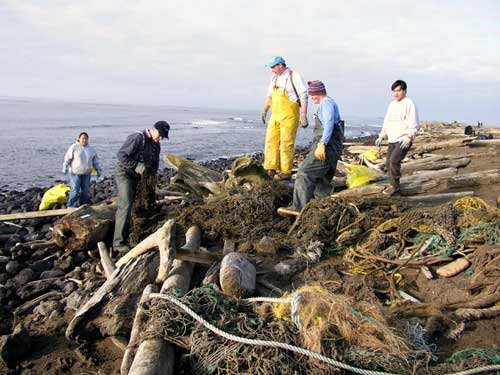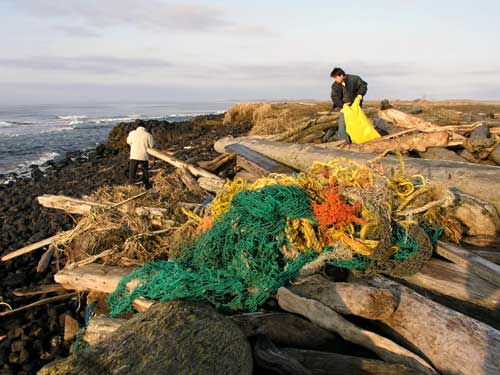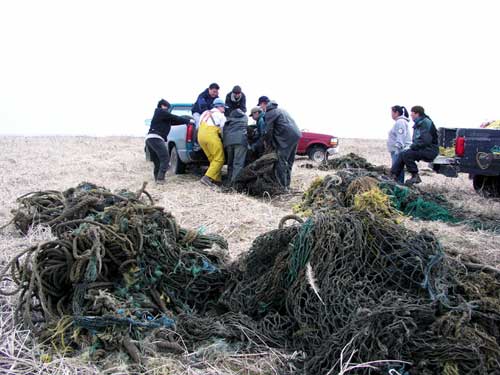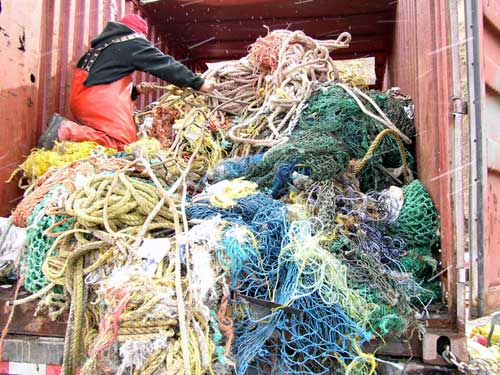 May 13, 2003
 MCA Executive Director Ron Clarke said the organization is embarking on an ambitious program of marine debris collection and removal. "We chose St. Paul Island as our first focus because of long-term local involvement, the amount of debris present, and the potential for wildlife entanglement in that debris," Clarke said. St Paul Island is the largest of five islands in the Pribilofs with a population of under 800. St. Paul has the largest Aleut population in the world and lies about 300 miles west of the Alaska mainland, and approximately 750 air miles west of Anchorage. St. Paul is an island about 40 square miles in size in the Bering Sea.
 Photo by Marine Conservation Alliance. In the summer breeding season, St. Paul is home to hundreds of thousands of Northern Fur Seals and millions of seabirds. Using pickup trucks, four-wheeled all-terrain-vehicles with trailers, pry bars, and their bare hands, cleanup crews wrestled debris out of the rocks, sand, and driftwood and transported it to a staging area at the Tanadgusix Corporation rock quarry. In addition to local workers, volunteers from the U.S. Coast Guard, the National Marine Fisheries Service, the U.S. Fish and Wildlife Service, LGL Alaska Research Associates, and the Pribilof Islands Stewardship Program - originators of the beach cleanup - joined in the effort. MCA Executive Director Clarke prowled the beaches as well. "We found tangled wads of nylon packing bands, plastic floats, polypropylene rope, huge hawsers and other heavy lines, fishing gear of all kinds, and other types of litter from all over the world," Clarke said. "On the last day, we tackled a big old net that had been working its way into the beach for years. It was like dragging up a ten-foot mop soaked in concrete. It was slow, sweaty, gritty work, but together, we got it out."
 Photo by Marine Conservation Alliance. Locally, the Pribilof Islands Stewardship Program - originators of the annual beach cleanup - and the ECO have been working for years to clean the seal rookeries and other beaches each spring before the animals return. "The MCA is pleased to join in these significant, ongoing efforts," Clarke said. "Firsthand experience on the beaches of St. Paul confirms that marine debris is a big problem - there's plenty of work for as many people as want to help." Dealing effectively with the problem will require cooperation of local communities, the fishing industry, Community Development Quota (CDQ) groups, seafood processors, environmental groups, the shipping industry, and even the military. "The people of the Pribilofs depend heavily on a healthy marine ecosystem, and the more of this junk we can remove, the better," Clarke said.
 Frank Kelty, Chairman of the MCA's Marine Debris Committee, explained these first loads were delivered to Unalaska/Dutch Harbor's landfill because the St. Paul landfill is full. "Ultimately, we want to find ways to recycle or reuse these materials," Kelty said, "and we're researching possibilities now. MARPOL [the International Convention for the Prevention of Pollution from Ships, an international treaty regulating disposal of wastes generated by normal operation of vessels] has helped shut off the flow of marine debris at the source, but fishing gear can still be lost accidentally, and materials can roll around in the water for decades until they wash up on a beach somewhere. We'll keep after it on all those fronts -- we're in this project for the long term." According to information provided
to Sitnews by the Marine Conservation Alliance, the MCA was established
in 2001 by fishing associations, communities, CDQ groups, harvesters,
processors, and support sector businesses to promote the sustainable
use of North Pacific marine resources by present and future generations.
The Marine Conservation Alliance stated in a news release that
the MCA supports research and public education about the fishery
resources of the North Pacific, and seeks practical solutions
to resource use questions to both protect the marine environment
and minimize adverse impacts on the North Pacific fishing community.
Source of News Release & Photographs:
|